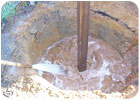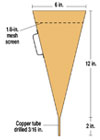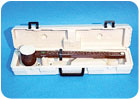
Drilling muds have four basic properties that determine the behavior of the mud as a drilling fluid – viscosity, density, gel strength and filtration. Several other properties, although of lesser importance, need to be checked, especially if problems are anticipated or encountered. These properties include sand content, pH (alkalinity or acidity) and calcium content (hard water). Although tests are available to measure each of these properties, simple field tests for viscosity and density, coupled with an understanding of drilling and the capabilities of available mud products, can satisfy the drilling needs for most applications.

Flow Resistance
Viscosity is defined as the resistance offered by a fluid (liquid or gas) to flow. The thicker a particular fluid, the higher its viscosity. Accurate measurement of the viscosity of drilling mud is dependent on a number of factors and requires special equipment. The basic factors which affect the viscosity of a mud are the viscosity of the base fluid (water); the size, shape and number of suspended particles; and the forces existing between particles, as well as between particles and the fluid.
For field applications, a qualitative viscosity measure can be obtained by the Marsh funnel. The funnel viscosity is the time in seconds for 1 quart of mud to pass through the Marsh funnel, expressed as seconds per quart. To determine the viscosity using the Marsh funnel, hold the funnel in an upright position and place a finger over the outlet. Pour the test sample, which has just been taken from near the pump suction end of the mud pit, through the screen into top of the funnel until the level of drilling mud just reaches the bottom of the screen. Place a cup under the funnel outlet. Remove the finger from the outlet and time the number of seconds for one quart of fluid to flow from the funnel into the cup. The number of seconds is recorded as the funnel viscosity. If available, a stopwatch should be used for measuring the time. The usual range of Marsh funnel viscosities for good effective bentonite mud is 32 seconds to 38 seconds per quart; for polymer muds, funnel viscosities of 40 seconds to 80 seconds per quart are reasonable. For comparison, the funnel viscosity of fresh water is 28 seconds per quart at 68 degrees F.
As a general rule, viscosity should be maintained as low as possible to provide the required hole stability and water loss control. Thin mud does the best job of cleaning the bit and optimizing the drilling rate, but thick muds are needed to remove coarse gravel from the hole. Marsh funnel viscosity readings should be taken routinely and recorded on the boring log.
For most drilling operations, acceptable limits can be obtained by adding approximately 50 pounds of bentonite per 100 gallons of water. Because the characteristics of the additives of polymer muds are quite different than those of bentonite, the solids content of polymer mud is much lower than the solids content of bentonite mud of the same viscosity. Natural clay muds, which occur as a result of drilling with clear water, are inferior to bentonite muds in their ability to increase viscosity. Much more clay is needed to achieve a given viscosity; the resulting mud will have a higher density and generally poorer qualities than a bentonite drilling mud has.
Video Spotlight
Mud Density
Density is defined as the weight per unit volume of drilling fluid. It is commonly reported as pounds per gallon or pounds per cubic foot. The desired density, which frequently is incorrectly called weight, for most drilling situations usually is less than 9 pounds per gallon, and can easily be determined by a mud balance.
To determine the density of the drilling fluid with the mud balance, fill the cup to capacity with fresh, screened mud. Place the lid on the cup and rotate the lid until it is firmly seated. Make sure that some drilling mud is squeezed out the vent hole. Wash or wipe the excess mud from the exterior of the balance. After the exterior surface of balance has been dried, seat the balance on the stand, and level by adjusting the rider. Read the mud density from the inside edge of the rider as indicated by the marker on the rider. Any of the scales on the rider may be used to express the mud density, although pounds-per-gallon is the most commonly used scales. The calibration of the mud balance easily can be checked by filling the cup with fresh water. It should read 8.34 pounds per gallon.
An increase in density of the drilling mud is a measure of how much drilled material is being carried in suspension and recirculated. Excess suspended solids are objectionable for several reasons. First, the cuttings generally are abrasive, and increase wear on the mud pump, drill string and bit. Regrinding of the cuttings also tends to decrease the rate of drilling progress. A thicker filter cake will be formed on the walls of the borehole as a result of the higher concentration of solids. As a result of the greater hydrostatic pressure caused by the higher concentration of solids, hydraulic fracturing of the formation is more likely to occur. Lastly, a denser fluid has greater buoyancy; therefore, the cuttings are less likely to settle out in the mud pit.
The density of the drilling mud should be routinely determined. Although there are situations when dense drilling fluids are desirable, measures should be taken when the density becomes too high. The density of a bentonite mud can be decreased by adding water, or increased by adding a finely ground, high specific gravity additive such as barite (barium sulfate). Polymer muds are not capable of suspending a weighting agent because they have little or no gel strength. However, since many polymers are compatible with salt solutions, polymer muds with densities of more than 11.5 pounds per gallon can be made by mixing the polymer with a saturated calcium chloride solution.

Particle Suspension
The measure of the capability of a drilling fluid to hold particles in suspension after flow ceases is referred to as gel strength (thixotropy). Gel strength results from the electrical charges on the individual clay platelets. The positively charged edges of a platelet are attracted to the negatively charged flat surfaces of adjacent platelets. In a bentonite mud in which the particles are completely dispersed, essentially all the bonds between particles are broken while the mud is flowing. When the mud pump is shut off and flow ceases, the attraction between clay particles causes the platelets to bond to each other. This coming together and bonding is termed flocculation. This edge-to-face flocculation results in an open card-house structure capable of suspending cuttings and sand and gravel particles. This property also suspends finely ground, high specific-gravity material such as barite when high-density drilling muds are required. The capability of keeping cuttings in suspension prevents sandlocking (sticking) the tools in the borehole while drill rods are added to the string, and minimizes sediment collecting in the bottom of the hole after reaming and before going back in the hole with a sampler. A drawback to this property is that cuttings do not readily settle out of the drilling mud in the mud pit and may be recirculated, resulting in grinding of particles by the drill bit, increased mud density, increased mud pump wear, and lower penetration rate.
Filtration
Filtration refers to the ability of the drilling fluid to limit fluid loss to the formation by deposition of mud solids on the walls of the hole. During drilling operations, the drilling fluid tends to move from the borehole into the formation as a result of hydrostatic pressure, which is greater in the hole than in the formation. As the flow of drilling fluid (water) occurs, the drilling fluid solids are deposited on the walls of the borehole, and thereby significantly reduce additional fluid loss. The solids deposit is referred to as a filter cake. The ideal filter cake is thin with minimal intrusion into the formation. The thickness of the filter cake for a particular mud generally is a function of the permeability of the formation. For example, the filter cake in a clay interval of the borehole would be thinner than in a sand interval.
Check out more drilling fluids tips!
Clean, well-conditioned bentonite drilling mud will deposit a thin filter cake with low permeability. Natural clay muds that result from drilling with clear water have much less desirable filtration properties than does high-grade sodium montmorillonite (bentonite). The natural clay mud will deposit a much thicker filter cake than that of bentonite mud. A thick filter cake has a number of disadvantages, which include the possibility that the cake may be eroded by circulating drilling fluid, may cause the drill pipe to stick, or may cause reduced hydrostatic pressure and partial collapse of the walls of the borehole during tool removal. The re-entry of drilling equipment into the borehole lined with a thick filter cake could result in a pressure surge with an accompanying increased potential for hydrofracture of the formation. Polymer muds are low-solids muds and do not form a filter cake as such. However, polymers tend to reduce fluid loss because they have a high affinity for water, and form swollen gels, which tend to plug the formation pores in the borehole wall.
This article is provided through the courtesy of the Army Corps of Engineers.




Report Abusive Comment